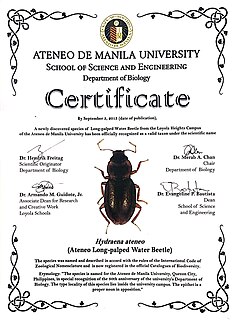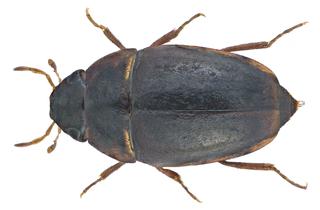
Hydraenidae is a family of very small aquatic beetles, sometimes called "minute moss beetles", with a worldwide distribution. These beetles are generally 1–3 mm in length with clubbed antennae. They do not swim well and are generally found crawling in marginal vegetation. Most are phytophagous but a few saprophagous and predatory species are known.

Ancyronyx, commonly known as spider water beetles or spider riffle beetles, is a genus of aquatic riffle beetles from North America, South Asia, China, and Southeast Asia. They are small beetles with extremely long legs ending in strong claws. Both the adults and the larvae are found underwater in the shallow riffles of streams and rivers, clinging to rocks or submerged wood. They feed on algae and decaying wood tissue. The genus contains twenty-one species, eleven of which are endemic to the Philippines.

Hydraena ateneo is a small aquatic beetle recently discovered in Metro Manila, the Philippines. It is predominantly brown, with yellow-brown antennae. Unlike other beetles in the genus Hydraena, Hydraena ateneo can be distinguished by its small size and distinct aedeagus. The species is named after the Ateneo de Manila University, Quezon City, where the species was discovered. The species can be found in freshwater areas around Manilla.
Neochthebius vandykei is a species of minute moss beetle in the family Hydraenidae. It is found in North America.
Neochthebius is a genus of minute moss beetles in the family Hydraenidae. There are at least two described species in Neochthebius.

Ochthebiinae is a subfamily of minute moss beetles in the family Hydraenidae. There are about 14 genera and more than 650 described species in Ochthebiinae.
Hydraena angulicollis is a species of minute moss beetle in the family Hydraenidae. It is found in North America.

Hydraena is a genus of minute moss beetles in the family Hydraenidae. There are more than 990 described species in Hydraena.
Ochthebius puncticollis is a species of minute moss beetle in the family Hydraenidae. It is found in Central America and North America.

Ochthebius is a genus of minute moss beetles in the family Hydraenidae. There are at least 460 described species in Ochthebius.
Cercyon marinus is a species of water scavenger beetle in the family Hydrophilidae. It is found in Europe and Northern Asia, North America, and Southern Asia.
Gymnochthebius fossatus is a species of minute moss beetle in the family Hydraenidae. It is found in the Caribbean Sea, Central America, North America, and South America.
Ochthebius lineatus is a species of minute moss beetle in the family Hydraenidae. It is found in Central America, North America, and South America.
Akephorus marinus is a species of ground beetle in the family Carabidae. It is found in Central America and North America.
Limnebius alutaceus is a species of minute moss beetle in the family Hydraenidae. It is found in North America.

Limnebius is a genus of minute moss beetles in the family Hydraenidae. There are more than 160 described species in Limnebius.
Sphenophorus marinus is a species of beetle in the family Dryophthoridae. It is found in North America.
Hydraena circulata is a species of minute moss beetle in the family Hydraenidae. It is found in Central America and North America.

Epimetopidae is a family of semi-aquatic beetles found on the edges of streams and shallow freshwater ponds. These beetles are shorter than half a centimeter long and have a pronotum with a central projection forming a shelf above the head. On the underside of the abdomen only four sternites are visible. There are less than a hundred species in three genera, Epimetopus which is restricted to the New World, mostly Neotropical, Eupotemus with two Afrotropical species and Eumetopus with some Oriental species. Females carry their eggcases on the underside of the abdomen.






